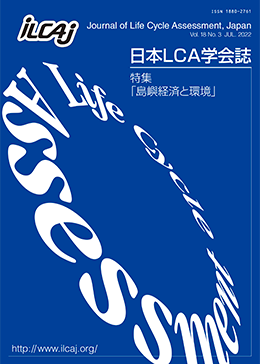Volume 18, Issue 3
Displaying 1-12 of 12 articles from this issue
- |<
- <
- 1
- >
- >|
Contents
-
2022 Volume 18 Issue 3 Pages Toc_1-Toc_4
Published: 2022
Released on J-STAGE: August 05, 2022
Download PDF (850K)
Foreword
-
2022 Volume 18 Issue 3 Pages 123
Published: 2022
Released on J-STAGE: August 05, 2022
Download PDF (829K)
Special Issue: Island Economy and Environment
Commentary and Discussion
-
2022 Volume 18 Issue 3 Pages 124-129
Published: 2022
Released on J-STAGE: August 05, 2022
Download PDF (1579K) -
2022 Volume 18 Issue 3 Pages 130-134
Published: 2022
Released on J-STAGE: August 05, 2022
Download PDF (2849K) -
2022 Volume 18 Issue 3 Pages 135-141
Published: 2022
Released on J-STAGE: August 05, 2022
Download PDF (1585K) -
2022 Volume 18 Issue 3 Pages 142-151
Published: 2022
Released on J-STAGE: August 05, 2022
Download PDF (4350K) -
2022 Volume 18 Issue 3 Pages 152-158
Published: 2022
Released on J-STAGE: August 05, 2022
Download PDF (1600K)
Report
-
2022 Volume 18 Issue 3 Pages 159-164
Published: 2022
Released on J-STAGE: August 05, 2022
Download PDF (1291K)
Introduction of Research Group
-
2022 Volume 18 Issue 3 Pages 165-167
Published: 2022
Released on J-STAGE: August 05, 2022
Download PDF (2246K)
Supporting Members
-
2022 Volume 18 Issue 3 Pages 168
Published: 2022
Released on J-STAGE: August 05, 2022
Download PDF (666K)
All about ILCAJ
-
2022 Volume 18 Issue 3 Pages 169-177
Published: 2022
Released on J-STAGE: August 05, 2022
Download PDF (1052K)
Announcement
-
2022 Volume 18 Issue 3 Pages i
Published: 2022
Released on J-STAGE: August 05, 2022
Download PDF (666K)
- |<
- <
- 1
- >
- >|
